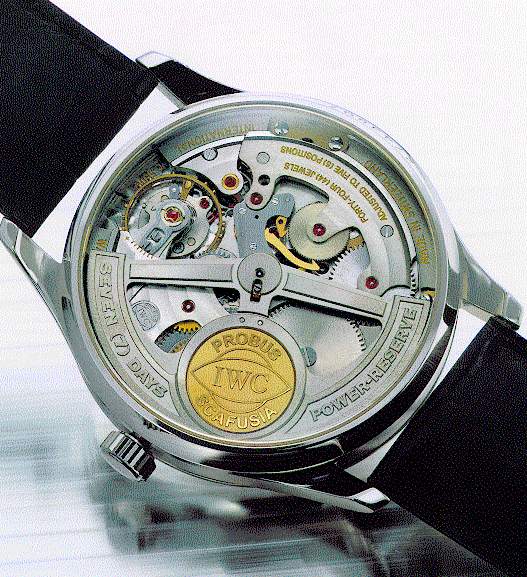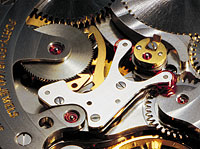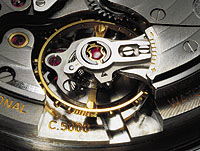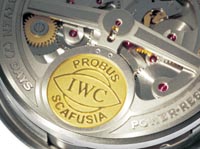

IWC's New Calibre 5000

This new in-house movement from IWC respects tradition while it breaks new ground. It is a pocket watch-sized movement made for the modern wristwatch. It combines the escapement of the famous IWC Cal. 89 with the famous winding system of the IWC Cal. 8541 in a totally new movement. The Cal. 5000 required almost four years to develop.
First, a brief overview--
It's huge --the movement itself is 38.2 mm wide and 7.2 mm high. Around 17 lignes, basically a pocket watch size, it's probably the largest series production, automatic wristwatch movement made today.
It's traditional --in some ways beyond anything else. The movement has the leisurely going rate of a pocket watch --18,000 beats per hour. This is in marked contrast to many of today's high beat movements and has the virtue of less wear at the trade-off of less resolution, but not less precision. The Cal. 5000 has an escapement derived from IWC's famed Cal. 89 manual movement, with a screwed balance and a Breguet overcoil. There's Incabloc shock protection.
It's also innovative. There's a much larger than typical power reserve, totaling 204 hours, through the use of an extra-large spring barrel. But what's fascinating is that the movement automatically stops after 168 hours --7 days-- to eliminate the danger of isochronism error by having the spring fully unwind. There's also a power reserve indicator on the dial and the watch winds fully to the 7+ day state after about a day and a half of wear.
Now some details (and a lot more will follow over the next 30 days, including diagrams showing how the components work)---
The Cal. 5000 is jeweled to the hilt --a total of 44. There's a total of 286 parts in 35 sub-assemblies, with 12 bridges and 53 differently shaped wheels.
The automatic winding system is basically IWC's famous patented system designed in the early 1950's by Albert Pellaton and featured in IWC's Cal. 8541. The rotor, cam, ruby rollers and pawl pattern are identical to the Pellaton design.
 Contrary to most
other watch designs, the movements of the rotor are not transmitted to a wheel
train via a gear system but instead move a heart-shaped cam to activate a
rocker. Two ruby rollers on the rocker ride on the cam, and the other end of the
cam uses a pair of pawls to transmit the kinetic energy to a ratchet wheel with
helical teeth, and from there to the winding wheels and barrel.
Contrary to most
other watch designs, the movements of the rotor are not transmitted to a wheel
train via a gear system but instead move a heart-shaped cam to activate a
rocker. Two ruby rollers on the rocker ride on the cam, and the other end of the
cam uses a pair of pawls to transmit the kinetic energy to a ratchet wheel with
helical teeth, and from there to the winding wheels and barrel.
While all that may sound complicated, the system has been called simple and ingenious. The winding system is noted for its efficiency, durability and ease of maintenance. The rotor winds bi-directionally and there is a sprung rotor mount to protect the rotor bearing from damage due to the mass of the rotor. Essentially, this part of the winding mechanism is shock resistant (the other parts of the winding system are not protected by this design, nor do they need it).
 The escapement,
too, has been based on IWC's finest traditions. There is a twin-arm balance with
16 screw weights and two adjusting cams, an IWC exclusive and similar to the one
used in IWC's famous Cal. 89. In fact, the balance, pallets and escape wheel are
identical to the Cal. 89. There's a Nivarox 1-chronometer quality balance
spring, a Breguet overcoil and a fine adjustment mechanism.
The escapement,
too, has been based on IWC's finest traditions. There is a twin-arm balance with
16 screw weights and two adjusting cams, an IWC exclusive and similar to the one
used in IWC's famous Cal. 89. In fact, the balance, pallets and escape wheel are
identical to the Cal. 89. There's a Nivarox 1-chronometer quality balance
spring, a Breguet overcoil and a fine adjustment mechanism.
There are numerous little characteristics reflecting great attention to detail, both respecting tradition and moving into the next century. The oversized barrel is a drum made of a special alloy, S-Korofestal (AiMgSi1), which is hardened warm and anodized. The toothed barrel wheel is separately screwed on. The seconds wheel is located under the escape wheel to enable a better view of the movement through the watch's display back. There's indirect seconds and indirect minutes --that is, the two drives are not powered directly by the wheel train. The entire power reserve mechanism is specially designed, with 18 different gearings.
Stepping aside from all the technical data, the Cal. 5000 is a product of great thought, design and engineering. It is made to be extraordinarily functional. The combination of perhaps more notable features than any other automatic watch movement today: its large size, slow beat, Breguet overcoil, screwed balance, shock resistant winding, 7 day autonomy, and isochronism correction --among other features-- all contribute to an efficient, durable, and fine working movement.
 It's a new movement
and it will be considered, with the benefit of hindsight, as a great movement.
It blends the best of tradition with quality innovation. Like the gold locket on
the rotor that states "Probus Scafusia", it reflects good, solid
craftsmanship from Schaffhausen.
It's a new movement
and it will be considered, with the benefit of hindsight, as a great movement.
It blends the best of tradition with quality innovation. Like the gold locket on
the rotor that states "Probus Scafusia", it reflects good, solid
craftsmanship from Schaffhausen.
The Cal. 5000 fully restores IWC to the hallowed halls of the great "manufactures".
Copyright 2000 Michael R. Friedberg
All rights reserved

Back to top of page | Return to Time Zone Home Page
Copyright © 1998-2000 Ashford Buying Co. Inc., All Rights Reserved
E-mail: info@TimeZone.com